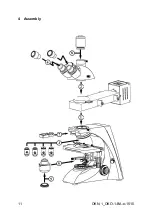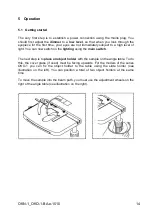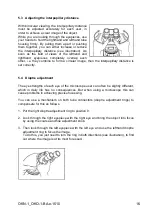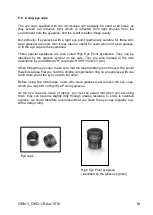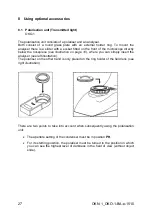
13
OKN-1_OKO-1-BA-e-1510
4.4 Eyepieces
You must always use eyepieces with the same magnification for both eyes. These
are simply placed onto the tube connectors, once you have first removed the plastic
protective caps. There is no way of fixing them. You should always make sure that
you do not touch the lenses with your bare fingers and that no dust enters the
apertures.
4.5 Colour filter
OKO-1
A blue colour filter is already an integral part of the condenser. It is screwed onto the
underside using a ring bracket. It can be removed at any time. In order to use
suitable filters without this holder ring, these can simply be placed in the ring bracket
of the field lens.
4.6 Condenser
OKO-1
We recommend that you use the course adjustment knob to bring the specimen
stage to its uppermost position. Use the focus dial of the condenser to move the
condenser holder to the central position. In this way the condenser can be fitted at
the right place in the condenser holder and fixed with the adjusting screw. When
doing this, you should be able to read the scale from the front. You should avoid
touching the optical lenses with bare fingers.
For points 7 (Polarisation unit) and 8 (Camera connection), please see Chapter
8 Use of optional accessories.
Summary of Contents for OKN 175
Page 2: ......
Page 7: ...OKN 1_OKO 1 BA e 1510 6 2 Nomenclature...
Page 8: ...7 OKN 1_OKO 1 BA e 1510 Rear view...
Page 9: ...OKN 1_OKO 1 BA e 1510 8 Reflected light unit...
Page 11: ...OKN 1_OKO 1 BA e 1510 10...












